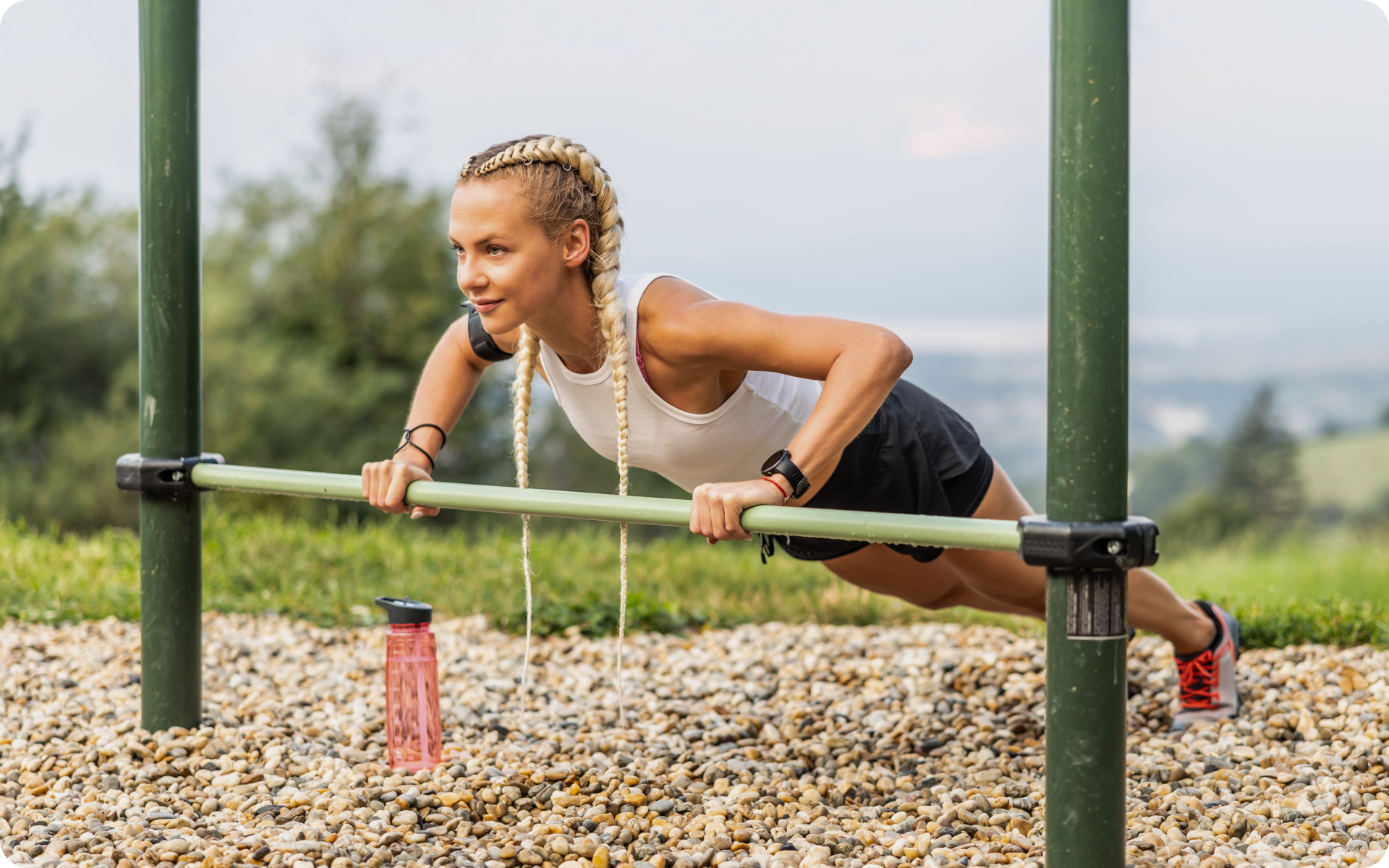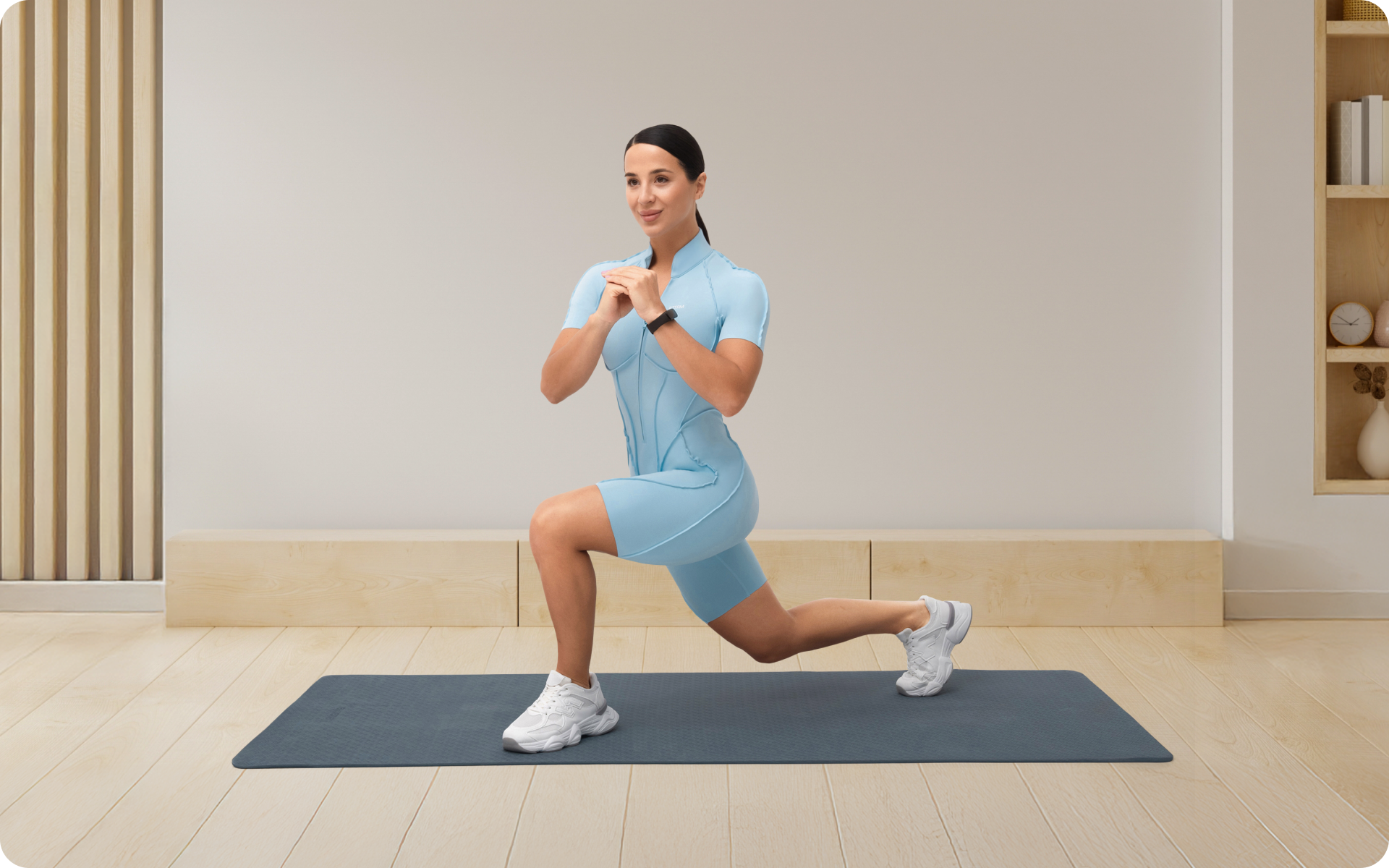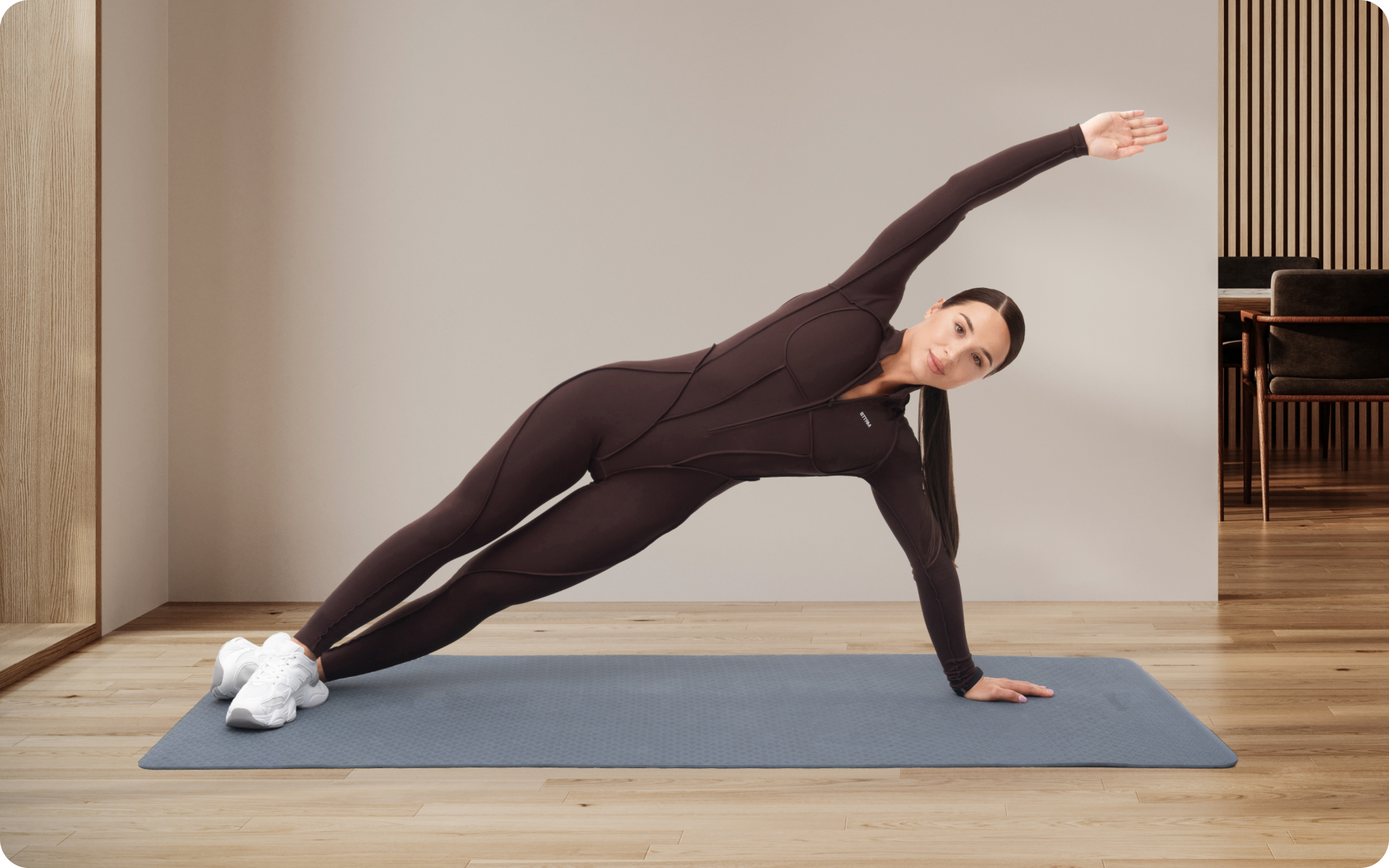Most people are stuck in tough routines and don’t have the time to work on their fitness. Taking the first step can be difficult, but once you start enjoying simple workout sessions, you may become eager to progress.
Calisthenics could be the answer to all your worries if you’re someone who has just entered the fitness world and doesn’t know where to start. You don’t need to hit the gym or enroll in a fancy workout program – simply learn calisthenics for beginners at home.
Using your body weight, calisthenics offers the benefits of a whole-body workout routine with little effort. The key is to include these in your workout sessions and work out regularly. The good thing is you can do calisthenics anywhere and anytime!
What Is Calisthenics?
Calisthenics is an exercise that uses body weight to engage muscles and build strength. Unlike traditional workouts, which rely on external weights like dumbbells or barbells to work out, calisthenics relies on body weight to build resistance. The word calisthenics is derived from the Greek words kalos, meaning beauty, and sthenos, meaning strength (6).
Calisthenics features a range of exercises, from simple movements such as squats or lunges to advanced movements that require a bar, such as pull-ups or dips.
The most defining feature of calisthenics is its emphasis on functional strength as it focuses on engaging multiple muscle groups simultaneously rather than isolating individual muscles. By activating different muscle groups at the same time, calisthenics improves flexibility and endurance.
As calisthenics can fit into any workout routine, it’s ideal for both beginners and seasoned gym-goers. In addition, it’s highly versatile, making it easier for individuals of all ages to work out using calisthenics.
How Do Beginners Start Calisthenics?
The intensity of calisthenics depends on the individual’s fitness level. If you’re a beginner, you need to first determine what areas you need to focus on and the frequency of exercise you aim to do. Try to create a calisthenics for beginners workout plan and schedule it in your routine.
If you don’t know which exercises you need to do, consult a certified fitness trainer who will create a customized calisthenics plan for you. As a beginner, you must aim to cover basic calisthenics such as squats, lunges, and push-ups.
You should initially perform calisthenics at least twice a week and gradually increase the frequency to three times a week. Give your body enough time and rest to recover after a full-fledged calisthenics workout. You can incorporate stretches into your workout routine to reduce muscle soreness.
Before you start working out, you should consult your physician regarding your workout plan and see whether it’s right for you. Once you get the thumbs up, you can start doing calisthenics workouts at home.
Here’s an overview of basic calisthenics for beginners at home that you can do anytime (1). Perform the following calisthenics workout circuit 3 times with a 30-second rest in between each set and a 3-minute rest between each circuit.
Yanking yourself back in shape has never been so easy with our game-changing fitness app! Start transforming your life with BetterMe!
Push-Ups
The first exercise on your calisthenics workout plan targets the arms, shoulders, and upper back. This traditional exercise has come a long way and is still considered the most effective for building upper-body strength. To do push-ups:
Find a comfortable corner and get on your knees by placing your hands underneath your shoulders. Extend your legs to get into a plank position by holding your body mid-air. Start lowering your body by bending your elbows until your chest almost touches the floor. Ensure your body is straight and your back doesn’t sag or stick upward in the air.
Your arms must form a 45-degree angle with your body when you’re in a push-up position. Pause for a second and then rise by pushing your body upward to the starting position. Make sure your core is engaged throughout the push-up.
Aim to do at least 20 push-ups and take a 30-second rest before you move on to the next exercise.
Add modification for those who can’t do full push-ups. The modification for this exercise is Knee Push-Ups.
Pull-Ups
Pull-ups also build immense muscular strength. They require a pull-up bar or any elevated surface where you can perform this exercise easily.
Adjust the pull-up bar according to your height. Face the bar and grasp it with your hands slightly wider than shoulder-width apart. Using your shoulder muscles, pull yourself up until your chin reaches the bar and your head is above it. Your back must be straight and your core must be engaged. You may choose to hang your legs in the air or bend them.
Rest for a while at the top and then lower yourself. Do 10 pull-ups and then proceed to chin-ups after taking a 30-second rest.
Add modification for those who can’t do full Pull Ups. The modification for this exercise is Jumping Pull Ups with Negatives.
Chin-Ups
Chin-ups are similar to pull-ups, but in this exercise, you need to grasp the bar with your palms facing you. Stand facing the bar and hold it slightly wider than shoulder-width. Pull yourself up until your chest reaches the bar and then lower down. Do 10 chin-ups.
Add modification for those who can’t do full Chin Ups. The modification for this exercise is Jumping Chin Ups with Negatives.
Dips
To do dips, you need a dip bar. You can also perform dips on two tables, benches, or exercise balls. Stand inside the dip bar and place your hands on it. Using your hands, lift yourself off the ground, lean forward slightly, and place your left foot on the floor. Bend your elbows and use your triceps to lift yourself up and down on the floor. Ensure your arms form a 45-degree angle when you lower yourself to the floor. Aim to do 20 dips.
Jump Squats
Jump squats are an advanced version of squats that exert more pressure on your core, legs, and thighs. They can help you build strength in your lower body using calisthenics.
To perform jump squats, stand on a comfortable ground with your feet parallel directly under your shoulders. Move your feet a few inches apart with your toes pointing outward. Start by lowering yourself into the squat position by bending your thighs. Keep your chest straight and your head facing forward. You may clasp your hands in front of your chest. Lower yourself into a squat until your thighs are parallel to your body and stop for a second.
Raise yourself by forcefully pulling your body into a jump and then landing on your feet. Aim to do 25 jump squats and then take a little rest.
Add modification for those who can’t do full Jump Squats. The modification for this exercise is Seated Squat or Normal Squat Exercise.
Read more: The Simplest Lower Back Calisthenics Guide for Beginners
Crunches
Crunches are generally incorporated to build core muscles and tone abs. Lie on a comfortable surface with your back flat against it. Place your feet flat on the ground and bend your knees at a 90-degree angle. Clasp your hands and put them behind your head. Engaging your core, sit up until your elbows reach your knees. Ensure your core muscles are properly engaged throughout the exercise. Breathe out when you pull up and breathe in when you lower down.
Burpees
Burpees are part of an “advanced calisthenics workout no equipment” model. They use your entire body and offer you the benefits of a full-fledged workout. Stand on a comfortable floor with your feet shoulder-width apart. Start by lowering into a squat by bending your knees and flaring your hips outward.
Get into a push-up position by lowering your body and placing your hands directly beneath your shoulders. Quickly get up and perform a jump squat by landing softly on the floor. When you perform burpees, ensure your back doesn’t sag and you engage your muscles properly.
Jump Rope
End the circuit by performing 30 seconds of jump rope. Stand on a comfortable floor and grasp the jump rope handles. Rotate the jump rope with your wrists while jumping off the ground. As you jump, keep your knees slightly bent.
Do this for 30 seconds and then take a 3-minute rest before you start the next circuit. Depending on your fitness level, you can vary the frequency of this circuit. As you gain strength and your body gets used to working out, you can increase the number of reps and circuits.
Can I Learn Calisthenics at Home?
Yes, you can absolutely learn calisthenics at home. Most calisthenics exercises, such as squats, lunges, and push-ups, require basic body movements and don’t need to be performed under the supervision of a trainer.
Many people prefer working out in the comfort of their homes. However, for advanced calisthenics, you should seek guidance by watching tutorials and researching online. The key is to exercise with the correct posture and form to reap the benefits of calisthenics for beginners (2).
If you’re new to calisthenics, start slowly by incorporating basic exercises such as squats or pull-ups into your routine. Once you master basic exercises, proceed to advanced exercises such as burpees. In addition, make sure to give your body rest in between workouts.
How Long Should a Beginner Do Calisthenics?
The intensity and frequency of calisthenics depend on the beginner’s fitness level, age, and preferences. Generally, it can vary from 40 minutes to an hour, including a warm-up session, stretching, and cool-down (3). If it’s for an older age group, the duration and intensity should be lower. For example, calisthenics for beginners over 40 should start with 30-minute sessions and increase gradually.
Try not to overwork your body. If you work out for over an hour as a beginner, this may do you more harm than good, as your muscles need time to recover. If you do less than 30 minutes, your body may not adapt properly to the exertion. A good calisthenics workout should leave you feeling fatigued but not overburdened.
If you wish to cinch your waist, tone up your bat wings, blast away the muffin top – our fitness app was created to cater to all your needs! BetterMe won’t give excess weight a chance!
Can I Start Calisthenics Without Equipment?
The primary concept of calisthenics is to work out using your body weight and resistance, so you don’t need special equipment to do it. The versatility and ease of calisthenics are what make it popular. Much more effective calisthenics such as push-ups, squats, and lunges don’t require any equipment and can help you build impeccable strength, mobility, and endurance.
What Are the Benefits of Calisthenics?
Calisthenics offers a litany of benefits, which makes it a must-do workout routine in any exercise plan. Doing calisthenics:
Boosts Fitness Levels
Calisthenics is good for cardiovascular health, as it helps improve endurance and strengthens the heart. Research has shown that fast-paced calisthenics is equivalent to running on the treadmill, so it offers the same health benefits as the latter (5).
Improves Strength
Calisthenics is the best for building muscular strength as it offers similar results to weightlifting. A study found that individuals who did calisthenics witnessed an increased strength than those who didn’t in a short period (7).
Improves Posture
Calisthenics can help improve posture by stretching muscles and ligaments. By engaging multiple muscles simultaneously, calisthenics can increase mobility and flexibility, which helps improve posture.
Improves Mood
Exercise is known to have positive effects on mental well-being and calisthenics is no exception. Research has shown that calisthenics helps improve the mood of individuals with certain diseases such as multiple sclerosis (4).
Read more: Calisthenics Shoulder Exercises: Techniques and Workouts
FAQs
What should I master first in calisthenics?
If you’re a beginner, you should first master basic calisthenics exercises, including squats, lunges, push-ups, and planks. These exercises require basic movements and don’t need expert guidance. Mastering basic calisthenics improves fitness level and flexibility, which prevents muscle injuries during advanced exercises.
Is calisthenics better than gym?
The choice between calisthenics and the gym depends on individual preferences. If your goal is to improve overall strength and fitness, you may opt for calisthenics, as it is multiplanar and engages multiple muscle groups simultaneously. It’s also convenient and versatile.
However, if you want to target a single muscle group, you can go to the gym, as weightlifting helps you target isolated muscle groups. If you’re a beginner, calisthenics is the better option.
Can you get fit with calisthenics alone?
Yes, you can get fit with calisthenics alone as long as you perform different sets of exercises and work out your entire body. The key to improved fitness is not just working out, but eating healthy meals and leading an active lifestyle.
How long should a calisthenics workout be?
If you’re a beginner, you may do calisthenics for 30 minutes and up to an hour, depending on your fitness level. You must do enough exercise to feel fatigued, but not strained by the end of the session.
The Bottom Line
Do you want to get fit without fancy equipment? Calisthenics is what you need!
It’s an exceptional form of exercise for beginners and regular gym-goers alike. If you want to optimize your health from the comfort of your home, check out calisthenics for beginners at home to build your strength and endurance. This isn’t just about short-term results; with consistent practice, you’ll be amazed at the strength, endurance, and coordination you build.
Remember, even small victories are worth celebrating. Be proud of every push-up you conquer and every lunge that gets a little easier. Calisthenics is a journey and the best part is that you’re in complete control. However, if you’re new to exercise or have any health concerns, you should talk to your doctor first.
DISCLAIMER:
This article is intended for general informational purposes only and does not serve to address individual circumstances. It is not a substitute for professional advice or help and should not be relied on for making any kind of decision-making. Any action taken as a direct or indirect result of the information in this article is entirely at your own risk and is your sole responsibility.
BetterMe, its content staff, and its medical advisors accept no responsibility for inaccuracies, errors, misstatements, inconsistencies, or omissions and specifically disclaim any liability, loss or risk, personal, professional or otherwise, which may be incurred as a consequence, directly or indirectly, of the use and/or application of any content.
You should always seek the advice of your physician or other qualified health provider with any questions you may have regarding a medical condition or your specific situation. Never disregard professional medical advice or delay seeking it because of BetterMe content. If you suspect or think you may have a medical emergency, call your doctor.
SOURCES
- 8 Calisthenics Exercises for a Basic Workout (2023, healthline.com)
- A Calisthenics for Beginners Workout That You Can Do Anywhere (2023, self.com)
- Beginner’s Calisthenics Workout | Personal Trainer Plan (2023, myprotein.co.in)
- Psychological effects of calisthenic exercises on neuroinflammatory and rheumatic diseases (2015, link.springer.com)
- The Acute Physiological and Perceptual Responses Between Bodyweight and Treadmill Running High-Intensity Interval Exercises (2022, frontiersin.org)
- The beginner’s guide to calisthenics (2020, mensjournal.com)
- The effects of a calisthenics training intervention on posture, strength, and body composition (2017, (content.iospress.com)













